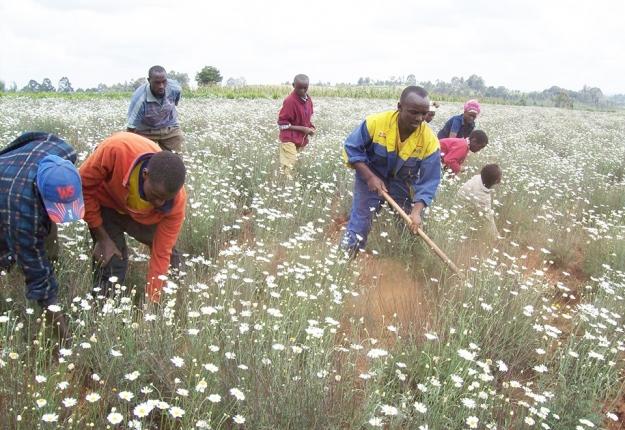 Farmers in a pyrethrum farm. Photo courtesy.
Farmers in a pyrethrum farm. Photo courtesy.
The government is planning to distribute 60 million pyrethrum seedlings to farmers in 19 counties beginning nest year in a bid to revive the sector which has been facing challenges for years now.
Kenya was the world’s leading producer of natural pyrethrum, providing 70 per cent of the global supply up to the late 1990s but beginning 2003, production started declining and Kenya lost the opportunity to Australia which took over the market with the island state of Tasmania taking over growing and processing in early 2000, according to a pyrethrum report from the Ministry of Agriculture.
However, efforts from county and national governments together with stakeholders have been in top gear to ensure the full revival of the sector.
Pushed by the latest market opportunities in United States and Asia, the government is now keen to support farmers to boost their production translating to up their income and the economy of the country.
The Cabinet Secretary for Agriculture Mwangi Kiunjuri said that over four investors have approached the ministry seeking to buy dried pyrethrum flowers.
“We are not ready to let such an opportunity fade away and it is in this regard that we have decided to provide farmers with certified and subsidised seedlings by the start of the longs rains next year,” said the Kiunjuri.
The plan will relieve farmers from the high expenses of buying the seedlings. For a farmer to put an acre under pyrethrum, one requires more than Sh40m to buy seedlings.
“This is prohibitive and many cannot afford, adding that it is because of this reason that they have decided to distribute the certified and subsidised seedlings,” said the CS.
RELATED ARTICLE: Government sets aside Sh1.5bn to revive pyrethrum farming
RELATED ARTICLE: Government finds machine to produce twice the pyrethrum from farmers\' plants
RELATED ARTICLE: Pyrethrum exports could plug the revenue hole, but Kenya still wants loans
According to the CS, buyers are willing to purchase a kilogram of dried pyrethrum flowers from Sh200-Sh250 but Kenya is pushing for more.
The 19 counties that the ministry has already tested their soils and found them fit for growing of the crop include Nakuru, Kiambu, Nyandarua, Nyeri, Laikipia, Meru, Embu, Baringo, Elgeyo Marakwet, West Pokot, Trans Nzoia, Bungoma (Mt Elgon), Uasin Gishu, Nandi, Kericho, Bomet, Narok, Nyamira and Kisii.
In this plan the CS is optimistic that in collaboration with the county governments 15,000-20,000 acres will be under pyrethrum in the next one year.
Kiunjuri is now encouraging women and youth to take up the opportunity and earn good income from the venture.
“I am encouraging women and youth to join groups and acquire clonal splits from the ministry and grow them to earn a living and help in seeds multiplication,” he said.
Kenya has the potential to produce and process 20,000 metric tonnes (MT) of pyrethrum flowers to earn Sh7.5 billion for farmers per year and Sh5.8 billion in foreign exchange from refined extract alone.
With direct or indirect linkage to the crop that best grows at an altitude of 1,700 to 2,900 metres above sea level, it can provide a livelihood to three million people.